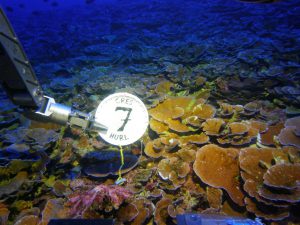The ability of deep, light dependent mesophotic corals to grow in low-light conditions is a poorly understood realm of biology. Research, sponsored in part by NCCOS, found that the ability of four mesophotic corals in the genus Leptoseris to use light for energy is dependent on the coral species and its type of symbiotic algae.
For light-dependent marine plants and animals, light is a critical factor for food, growth, and reproduction. Many hard corals contain symbiotic single-celled photosynthetic algae in their tissues called zooxanthellae. These algae, Symbiodiniaceae (formerly Symbiodinium spp.), produce food for the coral and in exchange receive nutrients and carbon dioxide needed for photosynthesis.

The study examined Symbiodiniaceae and coral hosts from 70–120 meters (230–394 feet) in the ‘Au‘au Channel, Hawai‘i. Results showed that each of the four species of Leptoseris (Leptoseris sp. 1, L. tubulifera, L. scabra, and L. hawaiiensis) used different strategies to maximize light capture including increasing the amount of pigment, decreasing cell size, and increasing the number of cells. These species may also use other sources for energy such as feeding on zooplankton or detritus to obtain the necessary nutrients for survival.
The study was supported in part by the NCCOS Deep Coral Reef Ecosystem Studies (Deep-CRES) project “Investigating the Deep (50–100 m) Coral Reefs in Hawaii.”
Citation: Padilla‐Gamiño, Jacqueline L., Melissa S. Roth, Lisa J. Rodrigues, Christina J. Bradley, Robert R. Bidigare, Ruth D. Gates, Celia M. Smith, and Heather L. Spalding. 2019. Ecophysiology of mesophotic reef‐building corals in Hawai‘i is influenced by symbiont–host associations, photoacclimatization, trophic plasticity, and adaptation. Limnology and Oceanography https://doi.org/10.1002/lno.11164
For more information, contact Kimberly Puglise.
